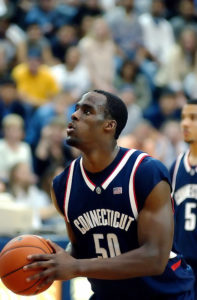Strategies to improve your free-throw shooting
Using a strategy that employs innovative free-throw shooting drills dramatically improved my team’s foul shooting over a number of seasons. After using these strategies, our team’s free-throw shooting percentage was 7 percent higher than in any of my previous years of coaching.
The following are some of the strategies you can use to practice free-throw shooting. The goals for each method are different and some of the methods require the players to “swish” the shot. Requiring players to swish the shot forces them to concentrate to a higher degree and to depend more on the “feel” of the shot.
Before practice
• Shoot 50. Players pair-up, take turns and shoot 50 free throws in groups of five or 10. Have them keep track of the number of successful shots.During practice
• Make first shot or do five push-ups. A player must make his or her first free throw or do five push-ups. This technique is especially effective after a hard run or physical drill. This helps players concentrate on their first shot and emphasizes the need to concentrate each time they approach the line and when they’re fatigued.
• Shooting streak. Players choose partners and alternate, with one shooting and one rebounding. An individual shoots until he or she misses. In the case of a very good shooter, limit the streak to 10 or fewer, and count the number of successful shooting streaks.
• Rebound, foul-shot game. This game is played to 21 with three or four players. To begin the game, the coach tosses the ball against the backboard. Each player fights for the rebound and the rebounder tries to score against the other players. When a basket is made, the scorer gets two points and goes to the foul line. The scorer shoots until he or she misses, up to five shots. As in a game, each foul shot counts as one point. On a miss, all players fight for the rebound and whoever gets the loose ball tries to score. If the shooter makes five foul shots in a row, you may proceed in one of two ways:
- Starting with the player with the lowest points, alternate shooters and have them shoot one at a time until there’s a miss to rebound and renew play.
- Have the coach toss the ball against the backboard to renew play.
This game places pressure on the shooter to make the shot, and often sends the shooter to the line when he or she is tired. With three or four players at each basket, your entire team can get quality work on rebounding and free-throw shooting.
• 5, 4, 3, 2, 1. Players line up at the foul line and shoot five shots each, then four shots each, etc. At the end of the drill, each player reports the total made out of the 15 shots taken.
End-of-practice drills
 • Team 1-and-1s. The team must make a certain number of 1-and-1 shots in order to end the practice session. To make this drill even more challenging, you can add stipulations that the shooter must swish the first or both foul shots.
• Team 1-and-1s. The team must make a certain number of 1-and-1 shots in order to end the practice session. To make this drill even more challenging, you can add stipulations that the shooter must swish the first or both foul shots.
• Two and done. At the end of practice, have a player shoot a 1-and-1 for the whole team. If the shooter makes both shots, practice is over. If he or she makes the first shot and misses the second, every player runs one sprint. And, if the first shot is missed, every player runs two sprints. After the sprints are run, you can pick another player to shoot, or have the same player go to the line and try it again.
• Team-percentage shooting. Players line up around the foul line and each takes two shots. The coach sets a total for the team to make. If the total is reached, then practice is over. If the total isn’t reached, everyone runs a sprint and lines up at the foul line to try once more.
Concentration is key
Early in the season, you must emphasize the importance of free-throw shooting. During the season, if you win a game by the margin of made free throws, point it out to players. If your team has had a bad night shooting free throws, try not to dwell on it or discuss it. Dwelling on missed free throws only tends to place more pressure on your shooters during the next game. However, after a bad night at the foul line, make sure you include additional free-throw training in the following practice sessions.
Successful free-throw shooting requires concentration. If your players aren’t giving the needed concentration during foul-shooting drills, make an announcement that the next foul shot is worth five push-ups for the entire team. If he or she misses the shot, everyone does five push-ups. Or, if the shot is made, everyone keeps shooting. This usually injects a much-needed shot of added concentration to a practice sessions.
Your drills shouldn’t be designed solely to place extreme pressure on the players. Instead, they should focus on the concentration aspect of foul shooting by setting team goals and recording individual shooting accomplishments. These methods and strategies have improved our practice experiences significantly and have helped our players become better free-throw shooters in games.









